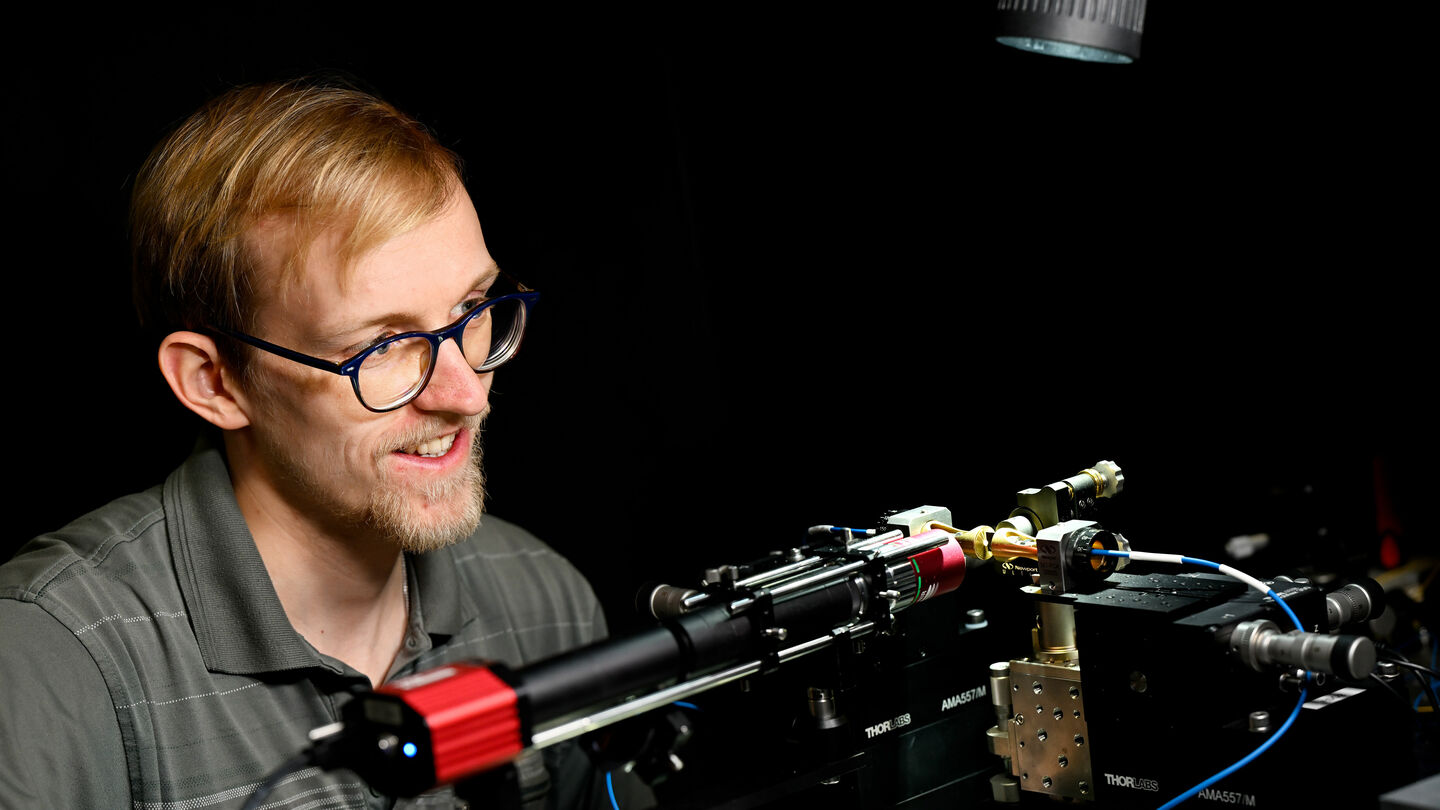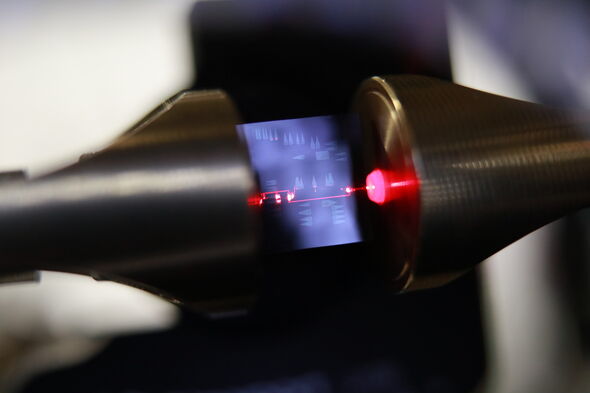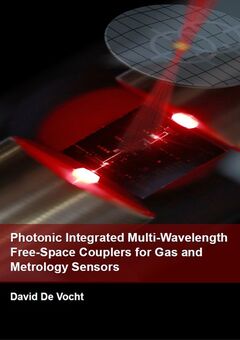
Home Stretch | Highway for light
David De Vocht developed a new method to guide light through an optical chip
In order to make optical sensors even smaller and more accurate, TU/e researcher David De Vocht has developed an innovative technology to transmit light through photonic integrated circuits. These new sensors allow for more accurate measurements of air quality – for example, in a classroom or a car. Today, De Vocht will defend his dissertation at the Department of Electrical Engineering.
David De Vocht is never at a loss for words. He is a real talker, and a fast one too. With a shrug, he apologizes in a distinct Flemish accent. “As a young boy, I was already known as ‘the chatterbox’. My mind is always racing.” That much is clear from all the projects he has set up over the past few years alongside his doctoral research. As one of the founders of the 632nm podcast, he has spoken with big names in science. Which have stuck with him the most?
“The man behind gravitational waves, Nobel Prize winner Rainer Weiss. Or geneticist George Church, one of the CRISPR pioneers and founder of the Personal Genome Project. And, of course, Federico Capasso, the inventor of the metalens, which I have personally worked with a lot. They offered an amazing glimpse behind the scenes about launching startups, discoveries that sometimes happen purely by chance, and the power of curiosity and perseverance. And I learned that, no matter how much you look up to these top researchers, they’re still just people. I’m more comfortable approaching unknown professors now, which often leads to unexpected conversations.”
In addition, De Vocht runs a discussion platform for young photonics researchers and gives career workshops at the international student association Board of European Students of Technology. “From leadership training to problem-solving skills. I had to take many courses to become a trainer myself. I regularly travel for a week at a time to give training sessions across Europe – most recently in Germany and Austria. Colleagues find it hard to understand how I can work so much alongside my doctoral research, but I don’t see this as working. Students are incredibly motivated and helping them gives me a great sense of satisfaction. And all the soft skills I’ve gained make me a stronger engineer, with quite a large network by now.”
Flat pancakes
Back to the core. Because despite all his ancillary activities – he quickly mentions his role as president of PhE, Photonics Society Eindhoven – De Vocht spent most of his time in the lab, he emphasizes with a smile. Amidst lasers, lenses and mirrors. In collaboration with ASML, ProDrive Technologies, SMART Photonics and Lionix Internationals, he was involved in designing a new generation of optical sensors.
First, a brief lesson on active optical sensors, says De Vocht. “Our eyes are passive; they capture light from our surroundings to identify objects. But active optical sensors emit (laser) light themselves. A lens then focuses this light on an object and you can use the reflected light to analyze the object. Such optical sensors are widely used in industrial processes to improve quality, safety and control. You can use them to detect dangerous particulate matter in the air, for example. They’re also crucial in semiconductor manufacturing. And there is an ever-increasing demand for more accurate measurements. That’s why we’re developing new technology that will allow us to make sensors smaller and more affordable for even more applications.”
So what makes the type of sensors developed by De Vocht and his colleagues so innovative? “We set out to integrate tiny optical components that can direct a beam of light, such as lenses and mirrors, into a single optical chip. So it’s everything miniaturized and on one single chip. The curved lenses you’re familiar with are not practical for such compact applications; they take up far too much space. So the lenses are flat like pancakes with a thickness of only a few micrometers.”
Keep your lane
All of this is to be able to accurately direct the light beam, De Vocht explains. He compares it to a highway, where motorists can only go in one direction. “We tried to develop technology that optimizes the selection of on-ramps and off-ramps for smooth traffic flow.” In the lab, De Vocht worked on an innovative solution to direct the light beam using optical couplers. He did not use regular lenses for this, but waveguide holograms.
“We send the laser light through a thin waveguide on our optical chips, like a highway for light. In it, we built a series of nanostructures that are smaller in size than the wavelength of the laser light. As a result, the usual principles of traditional optics no longer apply. The position of a nanostructure now determines in which direction the light is sent, while the thickness controls the light beam’s intensity. So we have an ultra-thin component that prevents the light beam from scattering in all directions and keeps it on its highway lane. Another remarkable thing is that we can do this with different colors of light.”
Building blocks
In addition to extensive experimental work, De Vocht also created a model of how the millions of nanostructures interact with light, and how they can influence it. “It took us days to calculate how the incoming light would emerge with the existing commercial software. Thanks to our model, we can now do it in seconds, which is very helpful in sensor design. In a follow-up study, we compared the experimental measurement results with the simulations, and it turned out that they matched very well.”
The building blocks with waveguide holograms and mirrors can eventually be used in small sensors for high-precision measurements. For example, in gas sensors that determine the amount of particulate matter in the air. “This could be used in a classroom, to create a better indoor climate for students, or in a car, for instance, where the ventilation could be adjusted automatically based on the measurements. I didn’t get that far, but we set up a foundation for practical applications. In the short term, I’m focusing on my defense, which, as a ‘chatterbox’, I’m very much looking forward to,” he admits with a gleam in his eyes. “An hour of unabashedly talking about my research.”
PhD in the picture
What is that on the cover of your dissertation?
"Four years of research captured in one image. A chip with incoming and outgoing fibers, and with a visual laser, we can trace the entire light path. I slightly enlarged the couplers because they’re so small, but you can see how brilliantly they can focus the light."
You’re at a birthday party. How do you explain your research in one sentence?
He laughs. “Quite a challenge for someone as talkative as me. That I’m trying to make optical sensors to measure particulate matter or very accurately determine a position in a machine even smaller so we can measure with even greater accuracy.”
How do you blow off steam outside of your research?
“I get a lot of energy from all my activities in various research communities, such as the soft skills training I give. I’ve also made some great friends through that, who I can play sports or grab a beer with.”
What tip would you have liked to receive as a beginning PhD candidate?
“Take the Mind your PhD course as soon as you start. It’s super interesting and useful. I only took it in my second year, but it would have been even more helpful to me at the beginning.”
What is your next chapter?
“I find the technology behind optical chips and sensors extremely interesting, so I would like to continue working on that. Whether I will do at the university or in industry, that’s still open. And as soon as I find my new position, I’ll continue expanding my coaching activities.”



Discussion